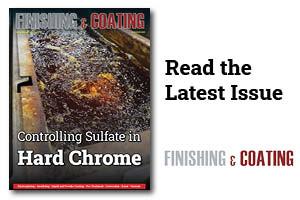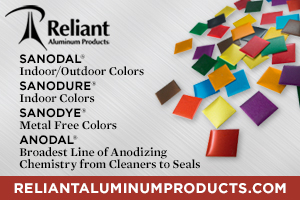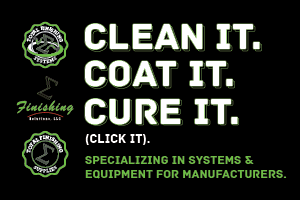Fresh out of the University of Washington, I went to Hill Air Force Base in August 1950, where I established the materials and processes laboratories to control metal finishing processes and to provide chemical/metallurgical support to various overhaul shops.
 Jack WoodThe U.S. Air Force has always been concerned with hydrogen embrittlement and stress relief. Ogden Air Logistic Center at Hill Air Force Base had, and still has, responsibility for logistic and engineering support for sophisticated weapon systems, landing gear, and other items. Because of this, overhaul and metal finishing operations have always been carefully controlled with detailed processing procedures. For example, a military standard for low-embrittlement cadmium plating was developed and put in use for Air Force shops and contractors.
Jack WoodThe U.S. Air Force has always been concerned with hydrogen embrittlement and stress relief. Ogden Air Logistic Center at Hill Air Force Base had, and still has, responsibility for logistic and engineering support for sophisticated weapon systems, landing gear, and other items. Because of this, overhaul and metal finishing operations have always been carefully controlled with detailed processing procedures. For example, a military standard for low-embrittlement cadmium plating was developed and put in use for Air Force shops and contractors.
As I was promoted over the years, I ended up deputy chief of the engineering division (a colonel and a civilian deputy managed Air Force divisions). My first love, however, remained with metal finishing operations. I remained close to metal finishing through my fatherʼs metal finishing shop, analyzing his solutions and performing other chores on Saturdays. I also stayed in contact with the Hill Air Force Base metal finishing shop.
With this background, we arrive at the point of this article: hydrogen embrittlement.
Note: The ongoing problems of hydrogen embrittlement in electroplated products prompted long-time AESF member Jack L. Woods to recall some of his experiences of more than 25 years ago. Here, Jack shares some of those experiences that caused failures in aerospace hardware. He enjoyed a very successful career at Hill Air Force Base, retiring as the Deputy Chief of Engineering. Jack died in 2018 at 92. This article was written in 2003, but remains relevant today.
Case 1: ICBM Rocket Nozzle Control Unit Bolts
 Anthony Montanez, Dennis Reeves and Brady Ringel, 576th Aircraft Maintenance Squadron technicians, prepare the first production A-10 Thunderbolt II for paint removal using a new robotic media blast technology Dec. 4, 2019, at Hill Air Force Base, Utah. The corrosion control technicians seal up the seams and holes in the outer-surface skin to prevent the blast media from entering the aircraft. (U.S Air Force photo by Todd Cromar)Missiles are sometimes sent back from operational bases for updating or for repair, if field testing confirms a problem. Nozzle control units are bolted to the missile, then covered with a silicone rubber boot to protect the unit from hot rocket exhaust gases. Upon removal of the boot, it was found that a bolt had failed and was lying in the boot. Metallurgical analysis confirmed that hydrogen embrittlement had caused the failure. How could this happen?
Anthony Montanez, Dennis Reeves and Brady Ringel, 576th Aircraft Maintenance Squadron technicians, prepare the first production A-10 Thunderbolt II for paint removal using a new robotic media blast technology Dec. 4, 2019, at Hill Air Force Base, Utah. The corrosion control technicians seal up the seams and holes in the outer-surface skin to prevent the blast media from entering the aircraft. (U.S Air Force photo by Todd Cromar)Missiles are sometimes sent back from operational bases for updating or for repair, if field testing confirms a problem. Nozzle control units are bolted to the missile, then covered with a silicone rubber boot to protect the unit from hot rocket exhaust gases. Upon removal of the boot, it was found that a bolt had failed and was lying in the boot. Metallurgical analysis confirmed that hydrogen embrittlement had caused the failure. How could this happen?
The bolt had serial numbers that allowed them to be traced back to the manufacturer, who had maintained sophisticated records. The bolt was part of a basket of bolts that were baked to remove hydrogen. It was determined that the failed bolt had fallen out of the basket before baking. The operator later saw the bolt on the floor and placed it in the basket of baked bolts. Why be concerned about one bolt? It could have caused a missile failure.
Case 2: Bomb Attach Bolt
A fighter aircraft on alert lost an unarmed 500-pound bomb that fell from a bomb rack onto the runway during the night. Metallurgical analysis revealed an inclusion in the bolt and signs of hydrogen embrittlement. The solution was to X-ray all bolts, and to ensure that cadmium plating was low-embrittlement with baking after plating.
Case 3: A C-130 Aircraft Landing Gear Shock Strut
Landing gear struts are treated with more care than one would treat a pet horse. Struts returned from Air Force activities are overhauled. This involves baking for stress relief, hard chromium plating removal using reverse current in a hot alkaline solution, grinding to remove pits, and hard chromium plating to a thickness of up to 15 mils. Finally, struts are ground to size. After each operation, a 23-hr bake at 375°F is accomplished. Now the problem:
After retiring from the Air Force in 1983, I was teaching a metal finishing course to new Air Force metal finishing personnel on the morning and afternoon shifts. During an evening break, I went into the plating shop to look around. As I walked by a pallet on which was a C-130 landing gear strut, I heard a noise that sounded like a good-sized firecracker exploding. The strut was waiting to be baked after hard-chrome plating, but had broken. Metallurgical analysis confirmed a fatigue failure most likely aggravated by hydrogen. The prior microcrack would have later been found if the failure had not occurred, and the strut would have been rejected following dye penetrant or magnaflux inspection.
The point of this example is that hydrogen embrittlement relief must be accomplished without delay after plating.
Incidentally, during the plating course, a young woman came to me with teary eyes. She said her mother was so worried about her safety that she wanted her to quit. The woman loved her job and wanted to be a plater. I called her mother and assured her of her daughterʼs safety, and told her of all the safety procedures in place. I invited the mother to visit the plating shop and offered to show her around.
Case 4: F-4 Fighter Aircraft Forward Engine Mounting Bolt Failure
 576th Aircraft Maintenance Squadron corrosion control painter Dale Benoit inspects newly applied paint on the underside of the new wing of an A-10 Thunderbolt II, tail no. 80-0252, at Hill Air Force Base, Utah, July 3, 2019. The aircraft was the last of 173 A-10s to receive new wings under the Enhanced Wing Assembly program to extend the flying service life of the fleet. (U.S. Air Force photo by Alex R. Lloyd)This problem reads like a detective novel and is perhaps the best example of hydrogen embrittlement and its remedy. About 25 years ago, I received a morning call from a senior Air Force maintenance officer from an F-4 fighter base. He informed me that the maintenance personnel had installed a new jet engine on an F-4 the night before. When they returned in the morning to pre-flight the aircraft, they found the engine in the bay. The forward engine mounting bolts had failed. I asked the officer to have the failed bolts immediately hand-carried to me. I received them late the same day. Upon seeing them, I noted that they were a beautiful, bright, shiny color, like bright plated fasteners found in a hardware store.
576th Aircraft Maintenance Squadron corrosion control painter Dale Benoit inspects newly applied paint on the underside of the new wing of an A-10 Thunderbolt II, tail no. 80-0252, at Hill Air Force Base, Utah, July 3, 2019. The aircraft was the last of 173 A-10s to receive new wings under the Enhanced Wing Assembly program to extend the flying service life of the fleet. (U.S. Air Force photo by Alex R. Lloyd)This problem reads like a detective novel and is perhaps the best example of hydrogen embrittlement and its remedy. About 25 years ago, I received a morning call from a senior Air Force maintenance officer from an F-4 fighter base. He informed me that the maintenance personnel had installed a new jet engine on an F-4 the night before. When they returned in the morning to pre-flight the aircraft, they found the engine in the bay. The forward engine mounting bolts had failed. I asked the officer to have the failed bolts immediately hand-carried to me. I received them late the same day. Upon seeing them, I noted that they were a beautiful, bright, shiny color, like bright plated fasteners found in a hardware store.
Hydrogen embrittlement was suspected because the bolts should have been an ugly, dull, frosty color. I immediately called the F-4 aircraft system manager and told him not to issue any more bolts and to recall all bolts in the field. I told him to ground all aircraft that had the suspect bolts installed. (The suspect bolts were easily identified by serial and lot number, and their brightness.) Because bolts were in short supply,
I asked the system manager to have all suspect bolts returned to the plating shop at Hill Air Force Base. I told him to have any that had been installed in engines destroyed and to report the number destroyed. Also, I asked the system manager to have the item manager inform me of the contractor that manufactures the bolts and how many had been made.
Our division’s metallurgical engineer was called to the office and asked to take the bolts to the metallurgical laboratory for analysis, and to prepare for a visit to the bolt manufacturer to determine what happened. Metallurgical analysis confirmed failure by hydrogen embrittlement. In the meantime, the bright plated bolts were being received by the plating shop. Instructions were given to the plating shop as follows:
- Strip the bolts of cadmium in an ammonium nitrate solution.
- Bake at 375°F for 23 hr.
- Low embrittlement cadmium plate (no brightener and a purified cyanide cadmium electrolyte).
- Bake at 375°F for 23 hr.
- Count the bolts and hold them for further instructions.
While the above was going on, three actions were in progress:
- Our metallurgist confirmed that the bolts were manufactured per drawing requirements. The cadmium plating, however, was outsourced to a local plating shop. A visit to this shop confirmed what had happened. The shop manager had, at first, followed the military standard regarding low embrittlement cadmium. He, however, thought that the ugly finish would not be acceptable, so he switched to bright cadmium. Bright cadmium plating is a beautiful finish, but it is dense, nonporous, and hydrogen cannot be removed by baking. The problem was found.
- The second action was to have one of our structural engineers have the Hill Air Force Base machine shop prepare jigs simulating the F-4 engine mounting hardware. The jigs were to be used to test the refurbished bolts in the same way they would be used for installing jet engines. The bolts were to be placed under this tension for 72 hours.
- The third action was to task our quality analysis people to provide the number of bolts to be tested, based on no failures, to assure a confidence level of 95 percent that the lot of bolts was okay to use.
The story becomes more interesting. No bolt failures occurred, so I told the F-4 aircraft system manager to release the bolts for use. He did this. A couple of weeks later, I was called to the office of the director of material management to explain why I had authorized the release of the bolts without his approval. I told him that I was hired to run the engineering division, and that the bolts were okay. He said that he was not so sure, because he had contacted a metallurgist who told him that hydrogen-embrittled bolts couldnʼt be saved and should have been scrapped. A heated discussion ensued, during which I asked him whether he was the director of material management (a generalʼs position) or an engineer. At this point, I took a 20-dollar bill from my wallet, placed it on his desk, and said, “20 dollars says no bolt failures will occur.” This broke the tension. Later, he was promoted to a Brigadier General. On his way to a new assignment, he stopped by to say goodbye and to thank us for our good support over the years. As he was going out the door, I said: “Hey, whereʼs my $20 for winning the bet?” He turned around, smiled, saluted me, and was gone.
A question arises: Can hydrogen be removed from parts that have not been placed under a load, or should the parts be scrapped? My belief, confirmed by this bolt fiasco, is that hydrogen can be removed if the tensile strength of the part in question is at or below a certain level.
Lessons Learned
Procedures in all metal finishing operations must be strictly adhered to. If an operator doesnʼt understand something or questions a requirement, competent management must be contacted. Also, personnel must be thoroughly trained regarding the insidious nature of hydrogen embrittlement.
This includes contractor personnel, as well as government inspectors who periodically visit contractor plants. The forward engine mounting bolt problem would not have occurred if all people in the production chain, including the government inspector, had understood that process procedures must be followed strictly.
Some new steel alloys are of such high strength that electroplating processes cannot be used because of hydrogen embrittlement concerns. For corrosion protection, vacuum-deposited cadmium was used. It has now been replaced with vacuum-deposited aluminum.
Jack L. Woods, CEF, holds a degree in chemical engineering from the University of Washington. He has been involved with metal finishing for more than 40 years. He is the author or co-author of more than 20 U.S. and foreign patents. Woods is a registered chemical engineer, a senior member of the American Chemical Society, and a long-time member of AESF. A resident of Ogden, UT, he is a member of the AESF Colorado Branch. For the past 15 years, he has been involved with the finishing of aluminum and has presented numerous papers in this field. In addition to his “hands-on” engineering and technical background, Woods has managed a large engineering division consisting of more than 400 people that provided engineering and technical support to aerospace systems, hardware, and software. He has taught university-level chemistry courses, and recently developed and taught a comprehensive metal finishing course for anodizers, electroplaters, and supervisors engaged in the overhaul of modern aircraft landing gear, aerospace hardware, and other critical items.



































